Contents
Dairy cattle are kept for milk production. A barren cow is kept for 2 years at the most: for the first time, barrenness could be an accident, but an animal that has become barren and in the second year is handed over for meat. But even with annual calving, udder diseases in cows can nullify all efforts to obtain milk. Unnoticed inflammation of the udder reduces milk yield by more than half.
Varieties of diseases of the udder of cattle
Types of diseases of the udder and their treatment in cows are not very diverse. In fact, there are only 2 diseases: edema and mastitis. But mastitis has at least 9 forms with 3 types of the course of the disease. Since one form of mastitis, if left untreated, can pass into another, they are not distinguished into separate diseases. Although some forms require specific treatment. But although the name of the udder disease is the same, the forms of mastitis look completely different in the photo.
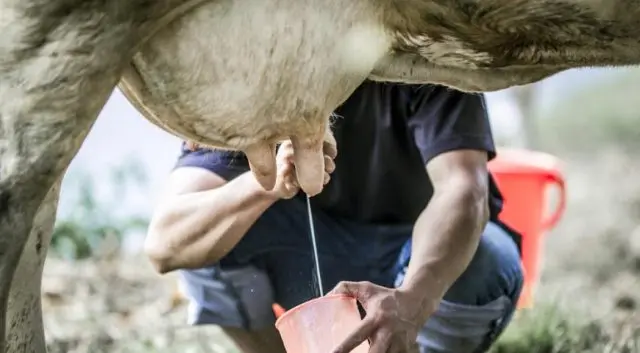
Edema
From the point of view of “classic” diseases, edema cannot even be called an udder disease in cows. It occurs 1,5-2 weeks before calving and is a sign of toxicosis, from which cows also suffer. That is, this is a kind of physiological reaction of the cow’s body to pregnancy. Edema disappears 1-1,5 weeks after calving.
Causes and symptoms
Movement during pregnancy is shown not only to people. The main cause of udder edema in a cow is the lack of a full-fledged exercise.
The udder is enlarged with edema. Smooth, while skin folds are present on a normal udder. When pressed, a slowly disappearing indentation remains on the skin.
Therapies
Treatment of edema is symptomatic: massage along the lymphatic vessels from the bottom up and a laxative inside. But the easiest way is to let the cow move.
As a preventive measure of the disease, shortly before calving, the percentage of succulent feed is reduced and the amount of dry feed is increased. Make the cows walk a lot. Drink from a bucket to control the amount of water consumed.
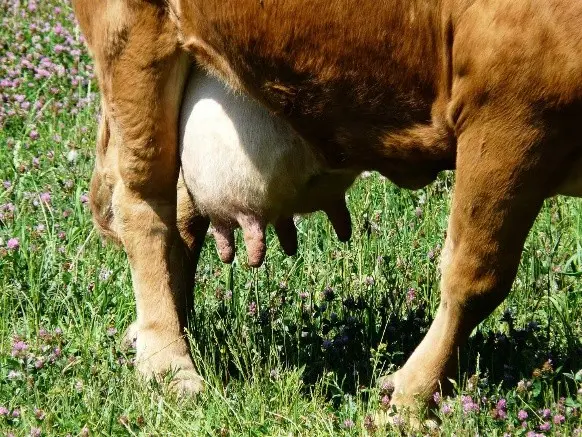
Mastitis
Mastitis is called inflammation of the udder. The forms of this disease of the udder in cows and their symptoms differ, depending on the cause of the onset and the speed of the decision on treatment. The disease can occur at any time during lactation. Sometimes a cow gets mastitis during the dry period. There are many varieties of this disease. Classification is carried out according to the nature of the inflammatory process:
- subclinical;
- serous;
- catarrhal;
- purulent;
- abscessing;
- phlegmonous;
- fibrinous;
- hemorrhagic;
- gangrenous;
- specific mastitis and complications after them.
The etiology of mastitis depends on the microflora that is the causative agent of the disease. Bacteria can also be a factor causing complications.
Causes and symptoms
The causes of mastitis can be very diverse:
- bruises;
- wounds;
- infection;
- intoxication;
- violations of milking rules;
- poor care of the udder and milking equipment;
- rough hand milking.
Some causes of illness overlap with each other. An uninfected wound will not cause mastitis, and it is difficult for infection to penetrate the gland in the absence of cracks in the skin of the udder.
The causes of intoxication can also be different:
- gastrointestinal diseases;
- decomposition of the placenta retained in the uterus;
- postpartum subinvolution of the uterus;
- endometritis.
The symptoms of the disease in clinical, that is, obvious, mastitis depend on the physical condition of the cow and the type of pathogen. Before treatment, it is necessary to conduct a diagnosis. The main attention is paid to the prevention of the development of subclinical (hidden) mastitis into an explicit form of the disease.
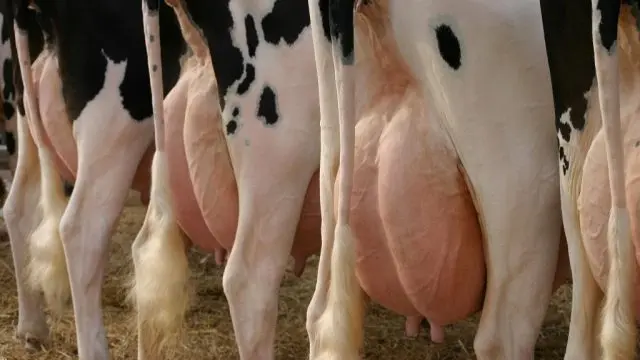
Diagnostics
Unnoticed subclinical mastitis quickly passes into an explicit phase. The disease is best treated in the initial phase, before it develops into a serious problem. Diagnosis of subclinical mastitis on the farm is carried out by a veterinarian in the laboratory. But it is difficult for a private owner to do such research. There are 2 ways to conduct an express analysis of milk for subclinical mastitis at home.
Straining
The milk is filtered through dark gauze in order to detect the presence of clots. If small flakes remain on the gauze after straining, mastitis is present. In the absence of disease, milk will not leave marks on gauze.
Upholding
10 ml of milk is poured into a test tube and kept in an ordinary household refrigerator for 16-18 hours. In the absence of mastitis, a cream layer of 5 mm is formed, there is no sediment. If the cow is sick, sediment will form in the bottom of the tube, and the layer of cream will be thin and mixed with mucus.
Symptoms of the clinical manifestation of mastitis
In addition to types, mastitis can also be mild, moderate, and severe. Symptoms vary, depending on the form and severity of the disease. If left untreated, one type of inflammation often progresses to another, more severe one.
Mild illness
In a mild form, subclinical, serous and catarrhal mastitis occur. In subclinical, there are no symptoms, but milk yield is slightly reduced.
With serous mastitis, the cow is slightly depressed, lame. Milk yield reduced. Milk from the affected lobe is liquid with a bluish tint. The local temperature is elevated. After milking, the swelling of the udder does not subside. Lymph nodes on the udder are enlarged. The skin is thickened, painful. With this form of the disease, the affected teats in cows are triangular in shape.
With catarrhal mastitis, the cow’s condition is normal. Milk yield is reduced slightly. With catarrh of the milk passages at the beginning of milking, you can see clots of casein. If catarrh has developed in the milk alveoli, clots appear at the end of milking. The local temperature is slightly elevated. After milking, the udder “deflates”. Slight enlargement of the lymph nodes. At the base of the nipple, dense strands and knots are probed. The shape of the nipple is oval.
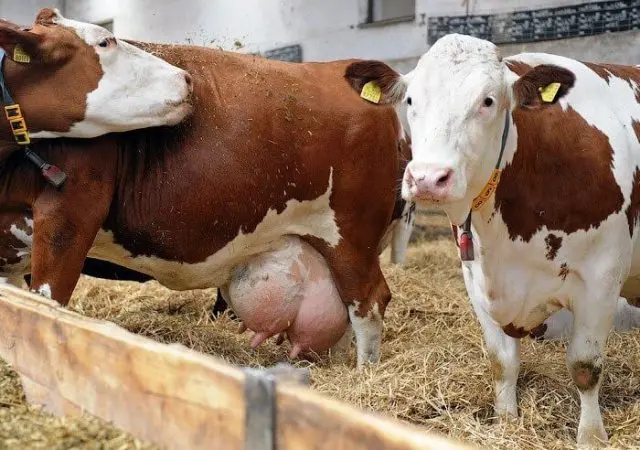
The average course of the disease
Further, mastitis passes into a purulent, abscessing or phlegmonous form. It is usually difficult not to notice the disease at this stage.
With purulent mastitis, the cow is depressed, lame. The chewing gum is missing. Body temperature 40 °C. There is no milk in the affected lobe. You can milk a small amount of mucopurulent exudate with yellow flakes. Udder lymph nodes are enlarged and painful. The skin is painful, hyperemic.
Abscessing mastitis is characterized by an increase in general body temperature and refusal to feed. A reddish liquid exudate with an admixture of pus follows from the affected lobe. Lymph nodes are hot, painful, enlarged. On the skin, seals or fistulas are observed.
Phlegmonous mastitis is one of the most severe forms with an “average” level of the course of the disease. The cow is strongly depressed, body temperature is increased to 41 °C. There is lameness and no appetite. The secretion of the affected lobe is reduced or absent. A secretion that stands out is grayish in color, with scraps of dead tissue. With this form of the disease, the skin of the udder in cows is cold, doughy, and lymphatic vessels are visible.
Severe illness
It is still necessary to be able to reach the severe course of mastitis. In a dairy cow, teat disease will become noticeable at a maximum in the middle stage. The cow will start to kick when you try to milk her. And it is most likely that the cow will begin to beat back at the beginning of the development of mastitis. A severe course is possible in dry, young or beef cows on large farms. Sometimes it is difficult to keep track of an individual in a large herd. The severe course of mastitis is expressed in fibrinous, hemorrhagic and gangrenous forms.
The fibrinous form of the disease is characterized by the depressed state of the cow, refusal to eat and lameness. The diseased lobe is hot, painful, greatly enlarged, crepites. Straw-yellow discharge from the diseased nipple with fibrin films. With this form of the disease, the skin of the udder is compacted and hyperemic. The lymph nodes are painful, hot and enlarged.
In the hemorrhagic form of the disease, emaciation is observed against the background of diarrhea. The affected part of the udder is hot, swollen and painful. There are almost no divisions. A small amount of exudate that can be milked, cloudy and watery, brown in color. Purple spots are visible on the skin of the udder. Lymph nodes are painful and enlarged.
The gangrenous form is practically untreatable. This is the final stage in the development of mastitis. It is characterized by sepsis, that is, “general infection of the blood” and fever. The patient’s share is cold due to the cessation of blood supply. A liquid exudate with gas bubbles is released. With the gangrenous form of the disease, a smooth film forms on the skin surface of the udder of a cow. The lymph nodes are very painful.
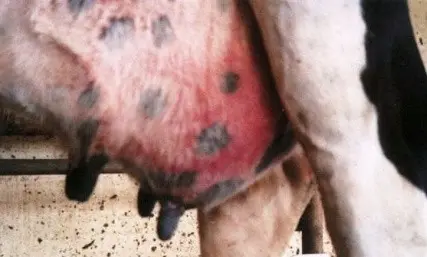
Therapies
Treatment of mastitis is carried out in various ways, depending on the form of the disease and the severity of its course. There are general principles for the treatment of mastitis:
- complex;
- early;
- continuous and permanent;
- providing rest;
- frequent milking every 3-4 hours;
- udder massage.
Specific measures are added to the complex treatment, which consists in increasing the immunity of the cow, depending on the type of inflammation. It is necessary to start treatment as early as possible, since the alveoli that produce milk die during the inflammatory process.
It is impossible to interrupt treatment until complete recovery, as the disease will return. Rest is provided to relieve tension in the mammary gland and reduce blood flow to the udder. To reduce milk flow, a sick cow is transferred to dry feed and limited in water.
The udder massage is carried out according to certain schemes: with serous inflammation from the bottom up along the lymphatic channels, with catarrhal inflammation – from the top down from the base of the udder to the nipples.
In the first days of the illness, to alleviate the condition of the cow, cold compresses are made on the inflamed part of the udder. After 4-5 days, the inflammation passes into the subacute stage, and the cold is replaced with heat. Warm compresses help dissolve infiltrates. Edema of the udder of any origin is reduced by prescribing once a day sodium sulfate in a laxative dose.
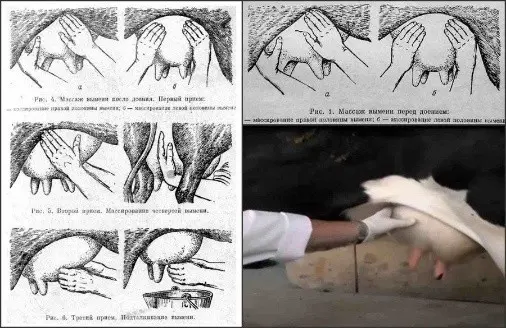
Treatment of some forms of mastitis
Specific treatment requires mastitis, accompanied by painful sensations:
- serous;
- fibrinous;
- hemorrhagic;
- early stage of an abscess.
In the treatment of these types of diseases, novocaine blockades are used.
In acute mastitis with high body temperature, antibiotic therapy is used. For best effectiveness, combinations of antibiotics are used:
- penicillin + streptomycin;
- oxytetracycline + neomycin;
- ampicillin + streptomycin.
Also, when a cow has inflammation of the nipple, oil-based antimicrobials are injected into the milk canal.
In the final stage of treatment, slightly irritating ointments are used to dissolve the remnants of the infiltrate.
Udder induration
This is an overgrowth of connective tissue in the udder. Complication after mastitis or prolonged untreated edema.
Causes and symptoms
The affected lobe is dense, does not fall off after milking. It remains large even in the dry period. Knots can be felt in the thickness of the lobe, or it remains evenly dense (meat udder). Pain is absent.
Over time, in the process of growth of connective tissue, milk production decreases. If the process takes place in the secretory part of the mammary gland, the quality of milk deteriorates:
- gray;
- mucous;
- the presence of flakes;
- bad taste.
Sometimes the affected area of the udder can be smaller, then it stands out with a very dense consistency.
Therapies
There is no treatment. Growth cannot be reversed.
Abscess
This is the next stage of catarrhal mastitis, which turned into an abscess form in the absence of treatment. In the photo, the abscessing stage of the udder disease in a cow with an already opened abscess.
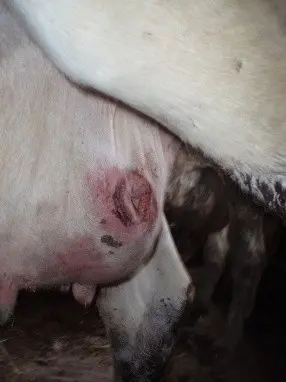
Carry out the treatment of abscessing mastitis.
Milk stones in the udder
A non-contagious disease that occurs due to metabolic disorders. Stones appear if phosphorus salts are deposited in the mammary gland or calcium is washed out of casein. Milk stones can also be the result of mastitis.
Causes and symptoms
There are only 4 reasons for the appearance of stones, but from very different areas:
- disorders in the endocrine system;
- unsanitary;
- mastitis;
- incomplete milking (leads to mastitis more often than to stones).
Stones may have a clay consistency or be hard. Their appearance is determined by probing the nipple. He becomes hard. When probing, seals are found. There is also stiffness.
Therapies
The udder before milking is washed with warm water and massaged from top to bottom towards the nipples. Loose stones in the nipples can be removed with a catheter. After that, when milking, pieces of stones are removed along with milk.
In more severe cases, all manipulations are carried out only by a veterinarian:
- surgical removal;
- destruction by means of ultrasound;
- oxytocin course.
Milk is edible, but it has low fat content and high acidity. It is more suitable for the manufacture of dairy products.
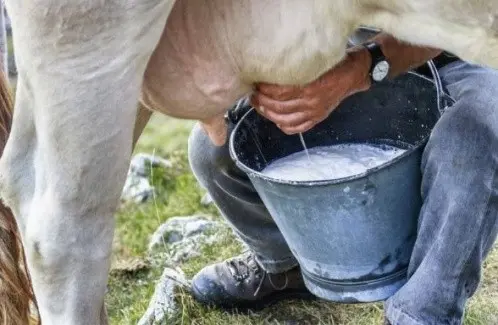
Milk incontinence
The scientific name for this phenomenon is lactorrhea. Occurs quite often. But one should not confuse streams of milk from a crowded udder with lactorrhea.
Causes and symptoms
The causes of the disease may be paralysis or relaxation of the sphincter of the nipple. But problems with the sphincter also do not come from scratch. The cessation of the work of this muscle can be caused by the following factors:
- tumor in the canal;
- mastitis;
- nipple injury;
- stressful state.
The difference between lactorrhea and discharge of milk from a crowded udder is that in case of illness, the udder may be half empty. But the milk will still drip.
Treatment either has not been developed or is not required. Everything will return to normal as soon as the cause that caused the relaxation of the sphincter is eliminated.
Hardness
This is not a disease in itself, but a consequence of other problems. The most common cause of stiffness is adhesions as a result of the inflammatory process. The nipple channel narrows, stops opening.
Causes and symptoms
With stiffness, milk comes out in a thin stream. Nipples harden, when probing, scars and adhesions can be detected. With tightness, there is a high chance that milk will remain in the udder. In this case, a vicious circle arises: mastitis-hardness-mastitis. Sometimes the channel can completely close.
Therapies
At the first signs of illness, milk is given as often as possible, even if it will be a painful procedure for the cow. To reduce pain, the nipples are massaged with anti-inflammatory ointment.
Bruises
A bump on a soft udder cannot appear, but a bruise is easy. Usually, a cow gets udder bruises when the content is too crowded. In a conflict between cows, one can hit the other. Fresh bruises are painful and the cow may resist milking.
Treatment is reduced to cold compresses for the first two days and warm in the following. If there are dense areas and blood in the milk, you should consult a specialist. There is a very high probability that the bruise has turned into inflammation.

Cracks
Often appear during lactation due to rough milking. Through the cracks, an infection enters, which leads to mastitis and furunculosis. To prevent illness, the nipples are smeared with a moisturizing ointment. Since Soviet times, inexpensive ointment for the udder “Zorka” has been popular.
Furunculosis
Bacteria penetrating through cracks in the nipples cause suppuration of wounds, which is called furunculosis. If hygiene is not observed, follicles can also become inflamed.
Causes and symptoms
With the development of furunculosis, the skin of the nipples becomes rough. At the initial stage of the disease, individual foci of suppuration can be distinguished. In the absence of treatment, suppuration grows. The skin of the udder becomes yellow-red.
Therapies
Treatment of the mild stage is symptomatic:
- cutting hair from the affected part of the udder;
- treatment of the clipped area with iodine and ichthyol ointment;
- opening mature boils and treating them with penicillin or streptocide powder, you can use an antibiotic spray.
It is desirable that the opening of boils was carried out by a specialist.
In veterinary medicine, udder diseases in cows include only edema and mastitis. The rest is either a complication after mastitis, or just one of the symptoms of infectious diseases: foot and mouth disease, smallpox or lumpy dermatitis. The reverse situation is also possible: mastitis is a complication of an infectious disease.
Papillomatosis
The mechanism of origin of papillomas has not been fully elucidated. They also often disappear on their own. It is known that one of the types of herpesvirus causes the disease. Papillomas appear when the immune system is weakened. Usually in young animals during growth.
In an adult cow, due to malnutrition, they can also appear. Usually papillomas are painless, but sometimes they can cause pain. In the event that they grew near the nerve.
During milking, an external papilloma may interfere with the operation of the machine or the hand. If the papilloma has grown inside the nipple, it can cause stiffness or pain.
Causes and symptoms
Very often, papillomatosis causes chronic fern poisoning, which destroys vitamin B₁. Due to beriberi, immunity is reduced, and the virus gains freedom of action.
Therapies
Although papillomas appear when immunity is weakened, it is impossible to inject an immunostimulant at this time. Together with the body, warts also “feed”. Treatment methods are associated with the prevention of the disease, since getting rid of papillomas is difficult, and often impossible.
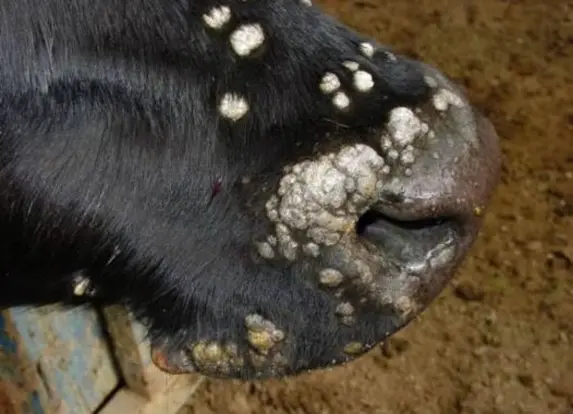
Smallpox
A viral disease that is contagious to mammals and birds. It is characterized by fever and rash on the skin and mucous membranes.
Causes and symptoms
The virus is usually introduced from the outside along with a sick cow that has not been quarantined. The incubation period of the disease is 5 days. Body temperature 41-42 °C. Skin lesions characteristic of smallpox in cows appear on the udder and teats. In bulls on the scrotum. There may also be rashes all over the body.
Cowpox is not dangerous to humans, especially when vaccinated. Milk from a cow with smallpox is boiled or pasteurized.
Therapies
Apply only symptomatic methods. Pockmarks are softened with fats, and ulcers are lubricated with aseptic preparations. Antibiotics are used to prevent complications.
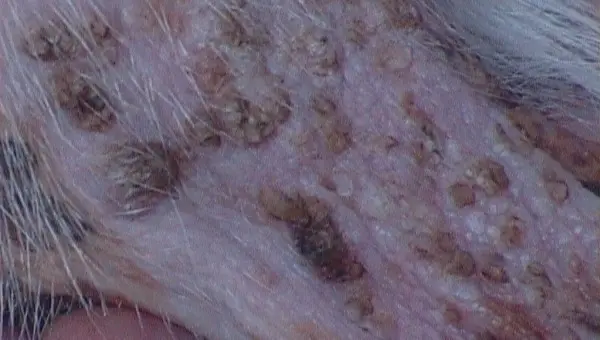
Foot and mouth disease
A highly contagious disease that affects all mammals. It is characterized by fever and aphthae on the mucous membranes, the skin of the udder, in the interhoof gap.
Causes and symptoms
The causes of infection are the appearance of a sick cow in the herd or the introduction of the virus on the shoes or clothing of staff. FMD symptoms are most pronounced in adult cows:
- decreased appetite;
- reduction in milk yield;
- increase in body temperature up to 40-41 ° C;
- appearance of aft.
Aphthae rupture after 12-48 hours, forming painful ulcers with torn edges and a reddish bottom. The temperature at this point drops to normal. There is profuse salivation and lameness. After a week, the erosion heals.
With a benign course, the cow recovers after 2-3 weeks. If there is a complication of a secondary infection, mastitis and pododermatitis develop. With a malignant course, the cow dies after 1-2 weeks.
Therapies
Sick cows are transferred to a separate room and given a course of immunostimulating drugs. The mouth is washed with antiseptic preparations. The affected areas of the udder and legs are surgically treated and antibiotics, antiseptic ointments and painkillers are applied externally.
Dermatitis
There are no separate “udder dermatitis” in cows. There is an allergic reaction, which can be expressed by redness and a rash. It is most noticeable on the udder, as there is too little wool. But similar signs of illness will be found all over the body of the cow.
There is a viral disease: lumpy skin disease. After the incubation period, the cow’s body temperature rises. Further, dense nodules appear on the skin. But also “all over the cow”. It is quite natural that these signs are most noticeable on cows with short smooth hair or where the hairline is very sparse (groin area). Nodular dermatitis also has nothing to do with udder diseases.
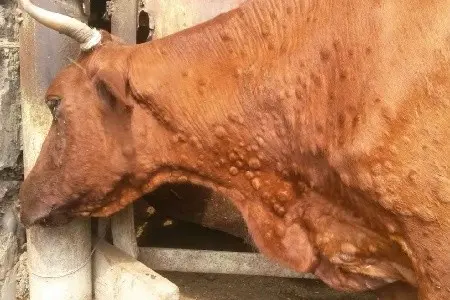
Preventive measures
Almost all diseases of the udder and teats in cows come down to one or another type of mastitis. Therefore, preventive measures also refer to the prevention of the development of this disease. Requirements for the prevention of infectious diseases are stricter and measures in this case are taken by others.
For the prevention of mastitis, cattle are kept in premises that meet zoohygienic requirements. The same preventive measures include providing cows with high-quality feed. If machine milking is practiced on the farm, then all cows are selected for suitability for this type of milking and increased resistance to udder diseases. With manual milking, rudeness is avoided: milking with a “pinch”.
One of the most important measures to prevent mastitis is the timely and correct start of cows. The launch is carried out 2 months before calving. After 7-10 days after launch, the condition of the udder and the presence of liquid in the teat are checked. If it was possible to milk only 15-20 ml of a homogeneous viscous substance, it is considered that the launch was successful. When milking a watery secret with casein clots with a volume of 50 ml or more, an anti-mastitis drug is injected into each nipple. If necessary, the administration of the drug is repeated after 10 days.
Conclusion
Udder disease in cows should be treated early in development. If you start even the easiest problem like cracked nipples, sooner or later it will turn into purulent mastitis, and it will all end with gangrene.










kam nje lop holshtein ka kaluar 1 jav nga data e lindjes dhe cicat I ka te thata ska hedhur fare gji a esht kjo nje shenje e masitit